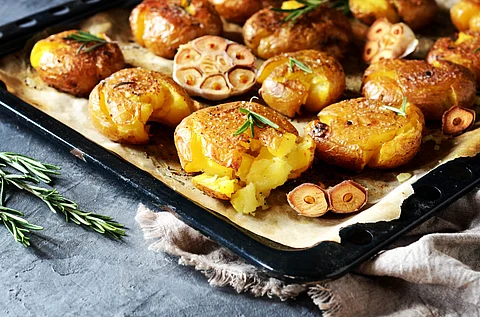
- Destinations
- Experiences
- Stay
- What's new
- Celebrating People
- Responsible Tourism
- CampaignsCampaigns
- Subscribe
- Buy Now

International Day Of The Potato | Global cuisine was never the same after European colonists brought the wild potato crop from South America to Europe, Africa and Asia in the 1500s. The starchy vegetable is now a dietary staple in many countries, including India where it is a key ingredient in aloo gobi, aloo chaat, dum aloo, aloo paratha, vada pav, puri bhaji, aloo methi, chilli potatoes, aloo bonda, samosa, malai kofta, and more such dishes.
According to the Food and Agriculture Organization (FAO) of the United Nations, May 30 is the International Day of the Potato. This year's theme is “Shaping history, feeding the future” because of the humble vegetable's widespread cultivation and consumption and deep historical and cultural significance.
If you’re curious about how the rest of the world uses potatoes in their cuisine, here are eight unique dishes you should tuck into during your next holiday.
These fried potato pancakes from Ecuador are stuffed with cheese and cooked on a hot griddle until crispy brown. They are usually served with salsa de maní (a peanut sauce), avocado, sausage, fried egg, tomato and lettuce salad on the side. Llapingachos are characterised by their crispy exterior, creamy interior and a peppery hint from the achiote shrub for a bright orange colour.
The dish allows for plenty of creativity, with Ecuadorians sometimes swapping potatoes with mashed, cooked yuca or cassava.
This is a traditional Irish dish of mashed potatoes and cabbage that is made on Saint Patrick's Day and the feast day of Saint Brigid. Its creamy consistency is achieved by adding milk, butter or cream. Colcannon often contains additional ingredients such as chives, onions, scallions and leeks, with salt and pepper as the only seasonings.
There are many regional variations of this staple dish, which can be paired with corned beef and cabbage as a side dish.
Kenyan bajias are a popular street food item consisting of thinly sliced potatoes seasoned with turmeric, cumin, chilli powder, garam masala, coriander, ginger, salt and black pepper. The potatoes are then battered and fried until golden brown.
This delicious street snack was originally influenced by Indians who were working on the country's railroad network. It is recommended that baijas be paired a mango chutney called madras.
The crispy daigaku imo are Japanese deep-fried potatoes coated with a sweet sugar glaze. Glossy and crispy from the outside, the potato chunks stay juicy, tender and soft on the inside. The name of this affordable treat translates to “college potatoes” and it is believed they first appeared among the student population in the early 1900s. Prior to serving, they are traditionally sprinkled with toasted sesame seeds and enjoyed as a nutritious snack.
Literally meaning “spicy potatoes,” this vegetable dish is native to Lebanon. It consists of potatoes, red peppers, coriander, chilli and garlic that are fried together in olive oil. They can be served plain or in a pita, accompanied by tahini sauce or a salad on the side.
Due to the crispy texture of spiced potatoes, batata harra is sometimes used as a filling for sandwiches.
A latke is a type of potato pancake or fritter in Ashkenazi Jewish cuisine that is traditionally prepared to celebrate Hanukkah. It is commonly eaten in Israel and the Jewish diaspora and has many variations.
They are most commonly made with potatoes, although other vegetables are also sometimes used. There are two primary varieties: those made with grated potato and those made with puréed or mashed potato. The original latkes were made of deep-fried ricotta.
This Korean pancake is prepared with grated or puréed potatoes, while some varieties may include scallions, chives, carrots or onions. The pancakes are usually small and round, and are pan-fried until they are golden brown and crispy on the outside.
They make an excellent snack, side dish, appetiser or light main course. Gamja-jeon are usually served with a choganjang dipping sauce that combines soy sauce, vinegar, sugar and water; or gochujang chilli paste, chilli flakes and sesame seeds.
Jansson's temptation is a traditional Swedish casserole made of potatoes, onions, pickled sprats, bread crumbs and cream. It is commonly made during Christmas festivities and Easter. The dish is also common in Finland where it is known as janssoninkiusaus.
There are a few theories as to the origin of this Swedish classic. One suggests that it was named after a 1928 silent film, while an older story says that it was named after the opera singer Per Adolf Janzon. The jury is out on which is the most credible origin story.
